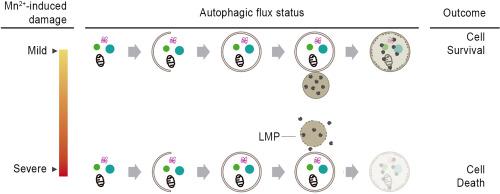Biochimica et Biophysica Acta (BBA) - Molecular Cell Research ( IF 4.6 ) Pub Date : 2020-06-24 , DOI: 10.1016/j.bbamcr.2020.118787 Soledad Porte Alcon 1 , Roxana Mayra Gorojod 1 , Mónica Lidia Kotler 1

|
Manganese (Mn) plays an important role in many physiological processes. Nevertheless, Mn accumulation in the brain can cause a parkinsonian-like syndrome known as manganism. Unfortunately, the therapeutic options for this disease are scarce and of limited efficacy. For this reason, a great effort is being made to understand the cellular and molecular mechanisms involved in Mn toxicity in neuronal and glial cells. Even though evidence indicates that Mn activates autophagy in microglia, the consequences of this activation in cell death remain unknown. In this study, we demonstrated a key role of reactive oxygen species in Mn-induced damage in microglial cells. These species generated by Mn2+ induce lysosomal alterations, LMP, cathepsins release and cell death. Besides, we described for the first time the kinetic of Mn2+-induced autophagy in BV-2 microglial cells and its relevance to cell fate. We found that Mn promotes a time-dependent increase in LC3-II and p62 expression levels, suggesting autophagy activation. Possibly, cells trigger autophagy to neutralize the risks associated with lysosomal rupture. In addition, pre-treatment with both Rapamycin and Melatonin enhanced autophagy and retarded Mn2+ cytotoxicity. In summary, our results demonstrated that, despite the damage inflicted on a subset of lysosomes, the autophagic pathway plays a protective role in Mn-induced microglial cell death. We propose that 2 h Mn2+ exposure will not induce disturbances in the autophagic flux. However, as time passes, the accumulated damage inside the cell could trigger a dysfunction of this mechanism. These findings may represent a valuable contribution to future research concerning manganism therapies.
中文翻译:

自噬在锰暴露的BV-2细胞中的动力学和保护作用。
锰(Mn)在许多生理过程中起着重要作用。然而,大脑中锰的积累会引起帕金森氏症候群,称为锰症。不幸的是,该疾病的治疗选择很少且疗效有限。由于这个原因,人们正在作出巨大的努力来了解神经元和神经胶质细胞中锰毒性所涉及的细胞和分子机制。即使有证据表明Mn激活小胶质细胞中的自噬,但这种激活对细胞死亡的影响仍然未知。在这项研究中,我们证明了活性氧在Mn诱导的小胶质细胞损伤中的关键作用。Mn 2+产生的这些物质诱导溶酶体改变,LMP,组织蛋白酶释放和细胞死亡。此外,我们首次描述了Mn 2+诱导BV-2小胶质细胞自噬的动力学及其与细胞命运的关系。我们发现Mn促进LC3-II和p62表达水平的时间依赖性增加,提示自噬激活。可能地,细胞触发自噬以中和与溶酶体破裂有关的风险。此外,雷帕霉素和褪黑激素的预处理均增强了自噬并延缓了Mn 2+的细胞毒性。总之,我们的结果表明,尽管对溶酶体的一部分造成了损害,但自噬途径在Mn诱导的小胶质细胞死亡中起着保护作用。我们建议2 h Mn 2+暴露不会引起自噬通量的干扰。但是,随着时间的流逝,细胞内部累积的损伤可能会触发该机制的功能障碍。这些发现可能代表了有关锰疗法的未来研究的宝贵贡献。











































 京公网安备 11010802027423号
京公网安备 11010802027423号